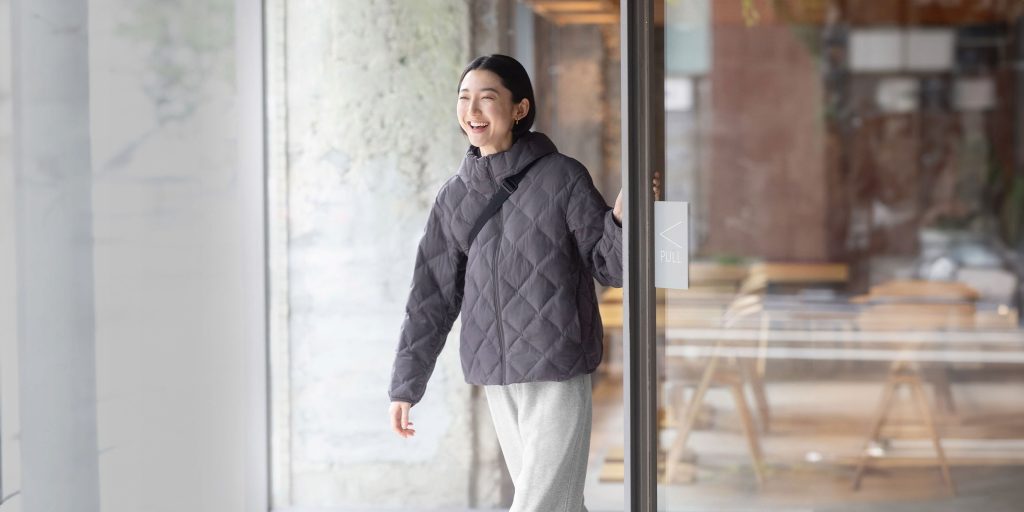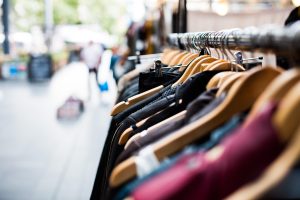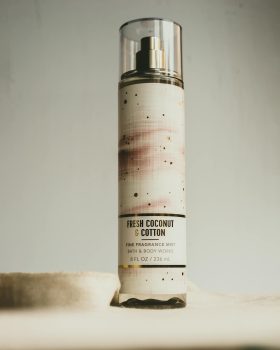While Gap is recognised for its casual, timeless, and affordable fashion offerings, Uniqlo, a Japanese fashion brand that is popular for its focus on quality, functionality, and simplicity in design offers affordable, everyday wear with innovative fabrics and attention to detail. Let us explore the underlying fashion philosophy of the Gap and Uniqlo, and their sustainability efforts and initiatives.

Uniqlo is among the most recognised names in global fashion retail. Image Source: uniqlo.com
Gap and Uniqlo are among the most recognised names in global fashion retail. While both brands cater to similar markets, their approach to design, pricing, sustainability, and expansion differ. This allows them to maintain a distinctive identity in the competitive retail landscape.
Gap, an American retailer with roots in casual wear, is synonymous with classic, comfortable styles that appeal to a broad demographic. Its design philosophy tends to lean towards timeless pieces, such as denim and everyday essentials. Per GQ, its “latest drop includes some of the most wearable, least pretentious menswear…”
On the other hand, Japanese brand Uniqlo has a minimalist and technology-driven approach to fashion. Known for its “LifeWear” concept, Uniqlo focuses on clothing that integrates functionality with simplicity, often utilising advanced fabrics and production techniques to enhance the wearer’s experience.
Per Forbes, “Durable fast-fashion is an oxymoron, but Uniqlo has found a way to make it work,” wrote Ken Morris, managing partner at Cambridge Retail Advisors. “I think that getting the logistics right was possibly even more important for Uniqlo’s bottom line than eliminating discounts. They are a leader in RFID technology and have truly embraced the model. They understand their inventory to the last item. They have fast checkout, security, inventory accuracy, can find products on the floor, ease of markdowns, fast and accurate receiving, and low prices..”
Table of Contents
- Gap vs. Uniqlo: Fashion Philosophy
- Gap vs. Uniqlo: Pricing and Affordability
- Gap vs. Uniqlo: Sustainability Efforts and Initiatives
- Gap vs. Uniqlo: Collaborations
- Gap vs. Uniqlo: Which fashion brand is right for you?
- FAQs on Gap vs. Uniqlo
Gap vs. Uniqlo: Fashion philosophy

Gap embraces the quintessential American casual wear style. Image Source: gap.com
When comparing Gap and Uniqlo, the intrinsic difference lies in their fashion philosophy. Gap embraces the quintessential American casual wear style. From denim to tees, the retailer offers a wide spectrum of classic, timeless pieces. Gap’s focus on well-priced essentials ensures that its customers can build a wardrobe with timeless basics. Per GQ, “The lightweight outerwear—from sturdy chore coats to juicy work jackets… get better with age. The pleated trousers and baggy jeans are some of the best in their categories, tough enough to wear into the ground but priced so democratically you won’t feel guilty about doing just that.”
In contrast, Uniqlo follows a minimalist and functional approach to fashion. Hailing from Japan, Uniqlo’s philosophy revolves around creating “LifeWear”—clothing designed to improve everyday life. Their designs focus on simplicity, functionality, and innovation, combining technology with fashion design to produce high-quality pieces at an affordable price point. The brand is acclaimed for its clean lines, neutral colours, and the use of innovative fabrics like HeatTech and AIRism, which provide both comfort and utility.
Gap vs. Uniqlo: Pricing and affordability
Price is a significant factor for most consumers. While Gap appeals to shoppers looking for deals, Uniqlo’s consistent, low pricing model provides value for those seeking essentials without waiting for sales.
Gap falls in the mid-range pricing category. While it is not a high-end fashion brand, the prices are slightly higher than fast-fashion competitors like H&M or Zara. Gap often positions itself as premium, offering high-quality materials and durable clothing. That said, the retailer frequently runs sales and promotions, making it easy for shoppers to score deals on otherwise higher-priced items.
Uniqlo, on the other hand, has built a reputation for offering premium basics at an affordable price. Known for its high-quality fabrics like supima cotton, Uniqlo maintains affordability while ensuring that their products are durable and well-constructed. What sets Uniqlo apart is its commitment to consistent pricing—while they also run promotions, the brand rarely engages in excessive markdowns, choosing instead to maintain a steady price point that reflects the value of their garments.
Gap vs. Uniqlo: Sustainability efforts and initiatives

Uniqlo takes a technology-driven approach to sustainability. Image Source: uniqlo.com
As sustainability becomes increasingly important to consumers, both Gap and Uniqlo have taken strides in addressing environmental concerns, though their approach differs.
Gap has faced criticism in the past for its environmental and labour practices but has recently taken steps to improve. The company’s “Gap for Good” initiative focuses on sustainability in materials, water conservation, and ethical labour practices. Gap has committed to using more sustainable fabrics like organic cotton and recycled fibres and also aims to reduce its environmental footprint by cutting greenhouse gas emissions across its global supply chain.
Per Gap’s website — “When you see this globe on a hangtag, know that this responsibly made style is part of our water-saving Washwell program or made with at least 50 percent of more sustainable materials. Our more sustainable materials include recycled materials, regenerative cotton, organically grown cotton, cotton-in-conversion to organic, U.S. Cotton Trust Protocol verified cotton, Tencel, Tencel × Refibra, Lenzing, Ecovero, Livaeco by Birla Cellulose, Eastman Naia, and partially plant-based EVA.”
Uniqlo takes a technology-driven approach to sustainability. Blue Cycle Jeans is poised to be a game changer, eliminating the need for large amounts of water and manual labour used to get that popular, faded look. This initiative significantly reduces the amount of water used in the jeans finishing process, by up to 99 percent. Laser distressing replaces sandpapering, reducing the burden of work done by human hands by using lasers to distress denim in all the right places. The use of lasers greatly reduces heavy manual labour and makes the work environment a better place for all. Uniqlo’s next-generation jeans are kind to people and the planet—and a huge step forward in sustainability.
The brand’s parent company, Fast Retailing, launched the RE.Uniqlo initiative, which focuses on recycling and repurposing used garments. Uniqlo encourages customers to bring back old clothes, which are then reused or recycled. Additionally, the brand is committed to minimising waste and reducing CO2 emissions throughout its supply chain. Uniqlo’s LifeWear philosophy is also intrinsically sustainable—its durable, timeless designs reduce the need for fast, disposable fashion.
Gap vs. Uniqlo: Global reach and Customer base

Gap has long been associated with American fashion. Image Source: gap.com
Gap and Uniqlo are both international giants, but their global reach and target markets differ in key ways.
Gap has long been associated with American fashion, and its presence is strongest in the United States, where it operates hundreds of stores. While Gap has expanded overseas, particularly in Europe and Asia, its global footprint is not as extensive or deeply ingrained as Uniqlo. And its customer base tends to be families and individuals looking for comfortable, casual wear.
Uniqlo, on the other hand, has expanded its global presence, with a significant focus on Asia, Europe, and North America. Uniqlo’s LifeWear philosophy and minimalist aesthetic appeal to a broader demographic of consumers, from young professionals to older adults seeking high-quality basics. The brand philosophy “Made for All” positions its collections to transcend age, gender and ethnicity. Uniqlo has also made significant headway in fashion capitals like New York, Paris, and London, positioning itself as a global leader in affordable yet innovative fashion.
While Gap maintains strong brand recognition, especially in North America, Uniqlo’s aggressive global expansion strategy has allowed it to capture a larger, diverse international audience. The brand’s presence in both emerging and established markets gives it an edge in terms of global influence and customer reach.
Gap vs. Uniqlo: Collaborations
Fashion collaborations have become a crucial strategy for brands looking to stay relevant, and both Gap and Uniqlo have embraced this trend.
Gap has its fair share of collaborations, partnering with celebrities like Kanye West for the Yeezy Gap line. The brand’s fashion collaborations focus on combining its casual aesthetic with the collaborators’ unique style, attracting both loyal customers and new audiences. In recent news, Gap is partnering with LA-based Cult Gaia on a collection of womenswear and kidswear, which will combine Gap’s essentials with Cult Gaia’s modern, sculptural influence. Gap has also renewed its relationship with Disney, for seasonal limited-edition collections. The first product drop, Gap × Disney Collegiate, has ’90s varsity-inspired apparel.
“It has been inspiring to bring two powerful brands together to create the Gap × Disney Collegiate collection for our customers with an elevated, style-forward point of view,” said Fabiola Torres, chief marketing officer at Gap. “After nearly 10 years of a successful partnership, we are turning up the heat with this drop that represents the next phase in our collaboration and offers looks for the whole family that champion original style.”
Uniqlo, however, is renowned for its popular collaborations with designer labels; a practice that elevates its tactile designs. The Uniqlo U line, designed by Christophe Lemaire, brings high-fashion to basics at accessible prices. Uniqlo has also collaborated with industry legends like Jil Sander, Jonathan Anderson, and Marimekko, offering limited-edition collections that marry minimalist design with an artistic vibe. These collaborations often sell out quickly, underscoring Uniqlo’s ability to capture consumer excitement.
Both editions of Uniqlo X Marni ruled the fashion news cycle. Per Vogue: “The first Spring Summer release was well-received globally… In the previous case, we had developed a whole wardrobe for summer, tapping into the notion of ‘LifeWear’ at large. This time around, instead, we decided to address the collaboration more directionally, focusing on fewer categories and offering a Marni interpretation of Uniqlo’s ‘Heattech’,” says Francesco Risso creative director of Marni.”

Kareena Kapoor Khan stars in the Uniqlo Fall Winter 2024 campaign. Image Source: uniqlo.com
Gap vs. Uniqlo: Which fashion brand is right for you?
When deciding between Gap and Uniqlo, the choice ultimately depends on your personal style, budget, and values. If you gravitate towards classic, all-American casual wear with an emphasis on denim, Gap could be your go-to brand. The brand’s frequent sales make it particularly attractive to shoppers looking for great deals on everyday essentials.
On the other hand, if you prioritise minimalism, innovation, and high-quality basics at affordable prices, Uniqlo may be a better fit. Known for its tech-driven fabrics, sustainability efforts, and global collaborations, Uniqlo delivers functional yet stylish clothing for those who value simplicity and performance.
For the eco-conscious, Uniqlo’s recycling programs and timeless designs are an attractive choice, though Gap is also making progress in sustainability. In the end, both brands bring something unique to the table, and your choice should reflect your personal preferences and lifestyle.
10 FAQs on Gap vs. Uniqlo
- Which brand is more affordable: Gap or Uniqlo?
Uniqlo is generally more affordable, but Gap frequently offers sales and promotions that can make their products competitive in price.
- What are the key differences in their fashion styles?
Gap focuses on classic American casual wear, while Uniqlo is known for minimalist, functional designs with a tech-driven twist.
- Are Gap and Uniqlo sustainable brands?
Both brands have sustainability initiatives, with Uniqlo leading through its RE.UNIQLO program and Gap improving through its Gap for Good efforts.
- Which brand has a larger global reach?
Uniqlo has a more extensive global presence, particularly in Asia and Europe, while Gap remains a strong brand in North America.
- Do Gap and Uniqlo offer fashion collaborations?
Yes, both brands collaborate with designers, though Uniqlo’s partnerships, such as with Jil Sander and Lemaire, are more frequent and widely acclaimed.
- Which brand is better for basic wardrobe staples?
Uniqlo is known for its high-quality basics at affordable prices, while Gap offers classic casual essentials with a focus on denim and casual wear.
- Are Uniqlo’s innovative fabrics worth it?
Yes, Uniqlo’s fabrics like HeatTech and AIRism are praised for their functionality and comfort, making them popular choices.
- Is Gap or Uniqlo better for sustainable shoppers?
Uniqlo may have a slight edge due to its recycling initiatives, though Gap is improving its sustainability efforts.
- Which brand is more popular in the U.S.?
Gap has a stronger presence and recognition in the U.S., but Uniqlo is rapidly growing in popularity.
- Where can I find better sales and promotions?
Gap frequently runs promotions, offering great discounts, while Uniqlo maintains more consistent pricing with occasional sales.
Read More:

Jasmeen Dugal is Associate Editor at FashionABC, contributing her insights on fashion, technology, and sustainability. She brings with herself more than two decades of editorial experience, working for national newspapers and luxury magazines in India.
Jasmeen Dugal has worked with exchange4media as a senior writer contributing articles on the country’s advertising and marketing movements, and then with Condenast India as Net Editor where she helmed Vogue India’s official website in terms of design, layout and daily content. Besides this, she is also an entrepreneur running her own luxury portal, Explosivefashion, which highlights the latest in luxury fashion and hospitality.











